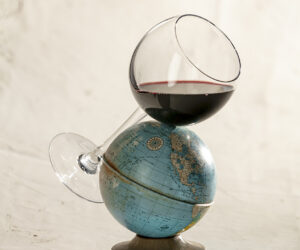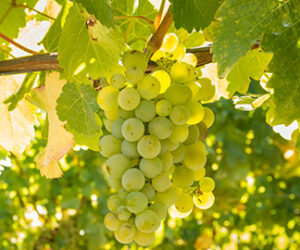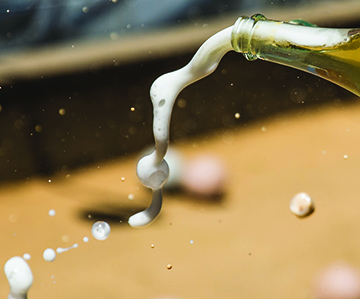
If you’ve spent any time hanging around wine bars or bottle shops over the past few years, you may have noticed what — taken at face value — appears troubling: Commercially-produced bottles of hazy wine, sediment and all, sealed with . . . crown caps. While your first instinct might be to speculate on what the winemaker was thinking or where the bottling line hygiene failed so catastrophically, what you’ve happened upon is actually one of the fastest-growing trends in the sparkling wine world: Pétillant-naturel (pét-nat for short). With its unpolished look and wild flavor diversity, pét-nat has gained a cult following among consumers ranging from adventurous winery visitors to sour beer aficionados, and is an overwhelming favorite of the wine world’s ever-increasing population of hipsters. But pét-nat isn’t anything new; in fact, it’s the oldest, simplest-to-make style of sparkling wine.
Méthode to the Madness
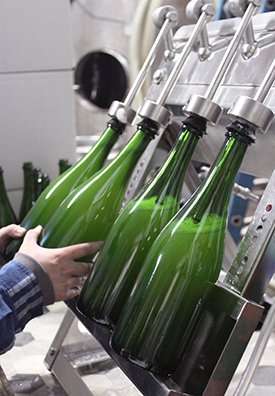
The term pétillant-naturel couldn’t be much simpler or fitting a name — it’s French for “naturally sparkling.”
Every winemaker understands that one of the by-products of fermentation is carbon dioxide. When crafting still wine, the racking and agitation that occur prior to packaging all but ensure the finished product will be bubble-free. But, if you ferment in a sealed vessel and don’t allow the gas to escape, the wine gains delightful effervescence. This is the essential step in the production of naturally-sparkling wines: Allowing fermentation to occur without an opportunity to vent carbon dioxide, thereby forcing the gas into solution.
So, is pét-nat just an unfinished analog of Champagne-style sparkling? Not exactly.
Champagne is produced via a meticulous process called méthode traditionnelle, in which base wine is fermented dry, clarified, stabilized, then sweetened and re-inoculated just prior to bottling. The bottles are left to sit en tirage (on the yeast) for a year or more, prior to a complicated settling and sediment removal process that requires loads of effort.
By contrast, pét-nat is made through a very simple process called méthode ancestrale, in which wine is bottled prior to the end of alcoholic fermentation and is ready to enjoy as soon as it reaches completion. No riddling, no disgorging. Just ferment, bottle, wait, and enjoy. Really, it’s that easy.
Is the Home Winery Pét Friendly?
So if pét-nat is so easy to make, does that simplicity translate to home wineries? Absolutely.
Given the relative lack of effort and equipment required for successful production, pét-nat is a perfect fit for home winemakers who are looking to give sparkling a try.
One of the most attractive aspects of pét-nat production in the home winery is the comparatively small amount of work and time that are required. While méthode traditionnelle wines require enough extra steps and aging time to intimidate even the most seasoned winemakers, méthode ancestrale wines simply cut out the middlemen between winemaking’s most critical steps: Fermentation and packaging. In general, pét-nat wines are ready to drink within a month or two of bottling, which allows the winemaker to evaluate their success or failure without an extended tirage period.
At the simplest level of pét-nat production, most of the required tools are items already present in most home wineries. While there are always upgrades that can be made to winemaking equipment, the basics are as follows: Fermentation vessel, bottling vessel, racking/bottling hoses, hydrometer, Champagne bottles, crown caps, and a crown capper.
With some careful decision-making and attention to detail, the home winemaker can make sparkling wines that rival, or even surpass, their commercial counterparts.
Taming the Naturel World
Though unpredictability may appear to be the ethos of méthode ancestrale wines, there are plenty of considerations that can be made in order to increase the chances of success. There are several metrics and protocols that may be leveraged to maximize the quality of pét-nat; the most important are juice chemistry, fermentation management, and bottling protocol.
Grape Variety Selection
Before discussing the ideal chemical parameters for pét-nat production, it makes sense to talk about some grape varieties that are particularly well suited to this unique style. While pét-nat may be made from anything bottled before completing fermentation, varieties that showcase bright acidity, less phenolics, and lower alcohol tend to make the most compelling wines. Vinifera varieties like Riesling, Albariño, and Pinot Noir are fantastic when produced in this style, but this is an avenue where hybrid and native cultivars really shine. Some of my favorite pét-nats have been made from grapes like Catawba, Diamond, and Marquette.
Juice Chemistry
In any sort of winemaking, the most important predictor of the finished product’s quality is the quality of the juice or must from which it started. Understanding juice chemistry is paramount in sparkling wine production.
In general, the juice characteristics that lead to a high probability of success in sparkling wine production are as follows: High acid, low tannin, adequate YAN (yeast assimilable nitrogen), and low sugar (17–19 °Brix for Champagne-style wines). In pét-nat these ideal parameters hold true, with the exception of starting sugar, which has a lower target range unless the winemaker hopes to leave behind some sweetness. Let’s look more closely at each of these parameters.
If bubbles are the heart of any great sparkling wine, acid is the soul. Effervescence and acidity have a synergistic relationship: Carbonation slightly acidifies wine and acid helps to integrate carbonation in a harmonious way. In most commercial sparkling wine production, grapes are selected for their acidity and are often harvested prior to reaching ripeness in an effort to retain this acid. Analyzing the titratable acidity of incoming juice or grapes gives the winemaker a picture of where his or her acid concentration stands prior to fermentation and allows for any necessary adjustments. In my experience, a titratable acidity (TA) value between 8-12 g/L tartaric acid is usually a good starting point for pét-nat.
While acid is a welcome and necessary component in pét-nat, the same cannot be said for tannin. Tannins interact with effervescence and acid to amplify astringency: The dusty, drying sensation associated with dry red wines. Some tannin is unavoidable and can even lend some weight to the mouthfeel of the finished wine, but an excess of tannin will lead to a wine with less than desirable flavor and texture. Tannin extraction can be minimized by limiting the contact time between crushing and pressing, and by separating free run juice from heavier press fractions. Not all home winemakers are equipped to process their own fruit, so these preventive steps may not be available. In that case, an assessment of the juice’s tannins is necessary. The clearest way to do this in the home winery is by tasting the juice. If the juice is judged to be overly astringent, excess tannin may be removed via protein fining with agents like egg white, skim milk, or gelatin.
The YAN of juice is the chemical parameter that most impacts fermentation health. Without adequate YAN, fermentation may become sluggish, stuck, or worse: Produce an array of unpleasant aromatic compounds. Too much YAN and your fermentation may run far too quickly for you to manage it appropriately; plus, any nitrogen that isn’t exhausted during primary fermentation becomes an attractive buffet for spoilage yeasts. If that isn’t daunting enough, YAN requirements vary greatly across yeast strains and fermentation conditions. It’s a lot to think about, but for the fermentation protocol that will be detailed in the next section, 100–200 ppm is generally the right neighborhood. YAN is a parameter that is often difficult to quantify in a home winery, but there are affordable, commercially available instruments that allow for this analysis. Alternatively, if you live near a winegrowing region there are probably nearby laboratories that will run a YAN analysis for a modest fee. Winemakers both amateur and professional will benefit significantly from clearer understanding of this data.
While the méthode traditionnelle ideals for acid, tannin, and nitrogen hold true for pét-nat, there’s definitely some wiggle room on the starting sugar level — that metric can shift based upon the desired effervescence, residual sugar, and alcohol of the finished product. There is a direct relationship between sugar content and the amount of alcohol and carbon dioxide produced by fermentation, both of which are critical to the character of pét-nat. In sparkling wines, an excess of alcohol has much the same effect as an excess of tannin — producing a hot, disconnected wine that is unpleasant from both a flavor and textural standpoint. Ideally, sparkling wines will end up somewhere between 9–12.5% alcohol, with traditional pét-nats skewing toward the low end of that range. Given that one can expect between 0.5–0.6% alcohol for every degree of Brix fermented, that places the ideal starting sugar range from 15-25 °Brix for sparkling wines.
There is, however, one factor that may affect this range: Residual sugar. If the plan is to leave some sugar to balance the acidity of the finished wine, a quick calculation can be made to adjust the starting sugar accordingly. Pressure may be leveraged in order to arrest fermentation and, in my experience, pressures above 6 atmospheres are effective in accomplishing this. When the internal pressure of the bottle approaches 6 atm, the yeast are inhibited and fermentation stops, leaving any remaining sugar unfermented.
As one atmosphere of CO2 may be produced from the fermentation of 4 g/L sugar, this generally requires between 2.4–3 °Brix more than the desired residual sugar level at bottling; packaging the wine while the sugar measures greater than 3 °Brix will ensure that some residual sugar will be left behind.
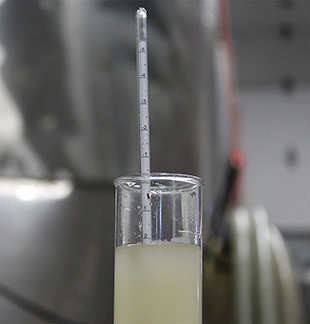
Fermentation Management
At first glance, the name pétillant-naturel might lead a winemaker to believe that the only correct way to produce these wines is a hands-off approach to fermentation, but that couldn’t be further from the case. While it is true that excellent pét-nats can be made using native yeasts and limiting intervention, an embrace of commercial yeasts, nutrients, and careful monitoring increases the probability that attempts to make these wines will be successful. The most critical aspect of méthode ancestrale winemaking is timing, and engineering a little bit of predictability into the process goes a long way toward recognizing and acting upon key moments in fermentation.
Though inoculation with commercial yeast may seem antithetical to the spirit of a style with “naturel” in the name, nobody ever made great wine with ideology alone. Uninoculated fermentations can be unbelievably complex and interesting, but they’re equally — if not more — likely to be faulty and sluggish. Pét-nat is already prone to a host of off-aromas and requires careful timing; faulty and sluggish fermentations ought be avoided at all costs. Inoculated yeasts, on the other hand, are predictable: Winemakers can source information on optimum temperature ranges, nutrient requirements, and a variety of other parameters that may be adjusted in order to maximize the potential of their wines. In sparkling wine production, the gold standard of commercial yeast strains is Lalvin’s EC-1118. A classic Prise de Mousse strain, EC-1118 is incredibly hardy; its low nitrogen requirement, competitive factor, steady fermentation speed, compact settling, and cold tolerance are all welcome attributes in méthode ancestrale winemaking.
Even when using inoculated yeast, close attention must be paid to overall fermentation health. After méthode ancestrale wines are bottled, the fermentation conditions are less than ideal for even the most robust commercial yeast strains and can lead to a variety of faults including sulfur off-aromas and volatile acidity. Assessing YAN content prior to inoculation and adjusting as necessary with a complex yeast nutrient like Fermaid K can help keep the fermentation clean through completion. For a hardy yeast strain like EC-1118, an initial YAN of 100–200 ppm should be sufficient.
As timing of bottling is critical for achieving desired pressure and/or residual sugar, careful monitoring of fermentation speed and temperature must be observed. Daily measurements of Brix and temperature can help the winemaker determine fermentation speed and make adjustments if necessary. If the fermentation appears to be proceeding too quickly it may be slowed by chilling to between 50–55 °F (10–13 °C), giving the winemaker time to track sugar depletion and prepare for bottling. As fermentation begins to approach the target for bottling, a precision hydrometer becomes an indispensable tool for accurate monitoring.
Bottling Protocol
CO2 is generated as fermentation proceeds. Unless the fermenting wine is bottled in a timely manner, the gas will escape, leaving a less-than-pétillant final product. Considerations made around bottling will have a direct impact on the carbonation, flavor, and appearance of the finished wine. Proper bottling timing, use of riddling adjuvants, and appropriate bottle/closure selection play significant roles in shaping the textural, organoleptic, and visual profiles of pét-nat wines.
Appropriate timing of bottling dictates the carbonation level and residual sugar of the finished wine. The winemaker would be well-served to have a target effervescence and sweetness level in mind prior to initiating fermentation, but on-the-fly adjustments may be made with regard to balancing sweetness and acidity. Daily Brix analysis and tasting allows for tracking of fermentation health, balance, and speed. As mentioned in the section on juice chemistry, 4 g/L sugar generates roughly one atmosphere of CO2, and fermentations may be arrested via pressure in the range of 6 atmospheres. This information can be weighed alongside the sweetness and effervescence targets in order to time bottling effectively.
An additional measure that may be taken to assist in timing bottling is to arrest the fermentation by chilling. If EC-1118 is used, chilling to 35–40 °F (2–4 °C) when the Brix reading drops to within a degree of the target should be sufficient to stop further depletion of sugar without killing the yeast. A secondary benefit of chilling the wine to arrest fermentation prior to bottling is tartrate stabilization. If tartrates are not effectively stabilized, they may precipitate in the bottle, which can lead to gushing — bubble seeding by wine diamonds can result in messy losses when bottles are finally opened.
The addition of riddling adjuvants may also help to prevent gushing by assisting in the compact settling of spent yeast. While there are a host of commercially available additives that may be used in this pursuit, standard issue bentonite is equally effective. Adding a properly-swelled bentonite suspension of 100–300 ppm prior to bottling will have a significant impact on the clarity and stability of the finished product.
A final consideration that needs to be made for safe and effective pét-nat production is the selection of proper bottles and closures. Crown caps are the preferred closure for wines of this style, as they are cost effective, simple to use, and hold pressure well. Corks may be used, but a wire cage is required in order to prevent them from pushing out of the bottles as they pressurize. For safety reasons, pét-nat wines should always be bottled in punted Champagne bottles. As the wine may reach pressures up to 6 atmospheres (assuming that it was bottled at 2.4–3 °Brix or higher), using a heavily reinforced bottle is the surest way to prevent a fun experiment in sparkling wine production from becoming a literal time bomb.
Following bottling, cellaring the wine at 50–60 °F (10-16 °C) for 1–2 months should be sufficient to allow for the fermentation to finish. The winemaker is advised to open the first few bottles over a sink or outdoors; for all the planning and attention to fermentation management, there is still an element of unpredictability to pét-nat, and unpredictability in sparkling wine usually means a mess.
Crown Capping it Off (Conclusions)
Though the earliest analogs of pét-nat wines were often both unexpected and undesirable, advances in the understanding of fermentation science have allowed winemakers to capture and leverage fermentation’s gaseous by-product to make complex, vibrant wines of distinction. The integration of modern winemaking technique and technology into méthode ancestrale has carried pét-nat out of obscurity and into the mainstream.
While pét-nat is enjoying growing commercial success, it’s a style that is particularly well-suited to home winemaking. With careful attention to a few key parameters, winemakers of varying experience levels can produce layered, lively, naturally-sparkling wines without the extended time, effort, or equipment investments required to produce wines via méthode traditionnelle.
So what are you waiting for? Next time you’re looking to add a new technique to your home winemaking arsenal, give méthode ancestrale a try. Follow the steps outlined here and you’re likely to succeed in making bright, bubbly, interesting wine. And if it doesn’t turn out perfectly — remember, pét-nat is unpredictable — well, that’s nothing a little orange juice can’t fix.


